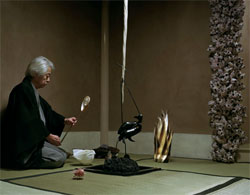Matthew Barney

The guiding metaphor for Matthew Barney’s series ‘Drawing Restraint’ (1987– ongoing) – that of using resistance to build up muscle tissue – is drawn from the world of athletics and fitness training. For bodybuilders who pursue this goal single-mindedly, the logical result is a mass of oiled and coiled muscles piled to bursting over a pair of slim Speedos. There are people who find this to be one of the definitive forms of human perfection, the result of work, discipline and focused effort; but to many of us it is just a tad unseemly; it's hard to see the point of it all. This problematic best describes Drawing Restraint 9 (2005), Barney’s latest achievement within the series, collectively shown at SFMoMA, along with its ancillary sculptures, drawings and photographs. The new instalment centres on Japan, its whaling industry and tea ceremony, and the American Occupation after World War II, then merges all these elements into metaphors of biology and the power of ritual.
Ritual with purpose we all understand, which is why the beginning of Drawing Restraint 9 is so successful. An elegantly dressed woman carefully and deftly wraps a strange-looking, rocky form as a gift; meanwhile a charming song plays, entitled ‘Gratitude’, based on a letter to General Douglas MacArthur thanking him for allowing the whaling industry to resume during the Occupation. We do not have to know the reason behind the choice of this unique stone; the beauty of this simple ritual is enough to engage our wonder. Paired with the music’s lilts, hooks and children’s chorus, which builds to a joyously festive climax, Barney gives the viewers enough cues to enjoy the work without ever having to explain any of its mystery.
Copious attention has been paid to the visuals that sustain the weave of referents running through the film, from the elaborate tea ceremony and furry kimonos to the now familiar satirical nubs. Barney has also gone to great lengths to get the music right, with genuine success; however, the Foley effects of the movie – the little sounds that help to enhance the images (say, the rustling of papers) – are unleashed in a torrent of minutiae. This film has more gastro-intestinal sounds than a chilli cook-off in Texas; Barney hammers our ears with every benthic gurgle, slimy crawl and gelatinous slurp, constant reminders of the materials that we are seeing, to the point of distraction. This is a definite false step, because it negates the one thing an artist needs from an audience: our imagination. Good filmmaking has much to do with what is left out and, more importantly, only suggested. This is especially true when forced to watch two hours of esoteric ritual, riddled with a surfeit of metaphors that, even though visually beautiful, collectively begin to drain a dangerously shallow pool of any meaning. The whole overburdened enterprise threatens to turn sculptures into props and photographs into money shots in self-lubricating frames.
One floor below the exhibition a single screen, installed as almost an afterthought, was the pearl in this craggy oyster of an exhibition: Barney’s performance for SFMoMA entitled Drawing Restraint 13 and Drawing Restraint 14 (2006). The artist, dressed as General MacArthur, walks down the same steps that are in front of the monitor. As he stands overlooking the museum’s entrance, he pauses and poses, and in one moment is not only a convincing MacArthur but much more. The video is funny without trying, surreal with little effort, and, when the man begins to climb the museum’s walls to make a drawing, embodies the graceful effort of a dance. Oddly this economical piece manages to counterbalance all the sound and fury occupying the entire museum floor above. Barney fails to realize the age-old dictum that truth is stranger than fiction. The artist is more compelling in a few stoic minutes with a corncob pipe and army uniform than yet another hybrid creature seemingly created by a pack of kids rolling a 20-sided die while playing Dungeons & Dragons.
The brilliance of Albert Einstein was not just in solving relativity; it was doing so in just three letters. Barney could also achieve far more with much less. In an era that has celebrated the output of slackers, his scope and vision provide a welcome counter balance. And nobody deserves that more than, as silent screen star Norma Desmond says in Sunset Boulevard (1950), ‘all those wonderful people out there in the dark’.

















